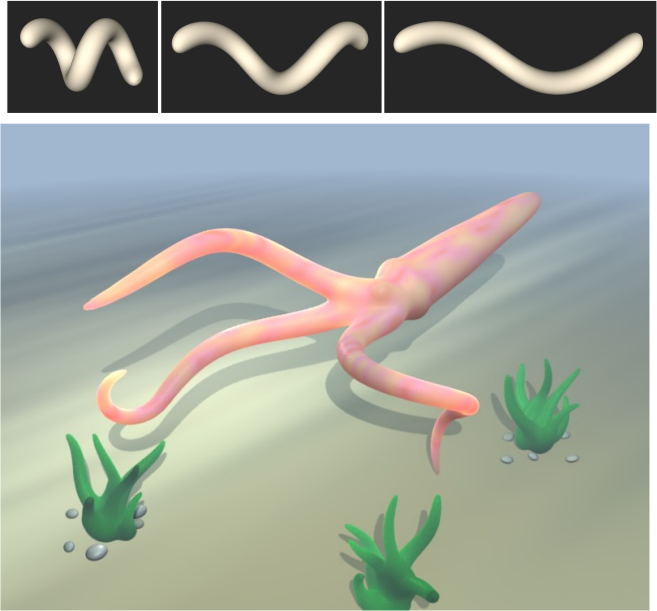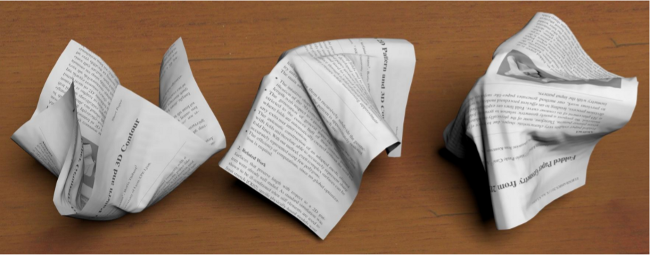Section: New Results
High level model for shapes
Constructive implicit modeling
Participants : Adrien Bernhardt, Marie-Paule Cani, Maxime Quiblier, Cédric Zanni.
Implicit surfaces are an appealing representation for free-form, volumetric shapes. In addition to being able to represent shapes of arbitrary topological genius, they have the ability to be constructed by successively blending different components, which eases interactive modeling.
Within Cédric Zanni’s PhD, we are collaborating with a researcher in formal computation, Evelyne Hubert, to improve and extend the analytical methods for computing closed form solutions for convolution surfaces. We introduced a warping method for enabling the modeling of complex helical shapes from a single implicit primitive (fig. 3 ), which greatly enhances efficiency [14] . We also proposed a method based on anisotropic, surface Gabor noise, for generating procedural details on skeleton-based implicit surfaces. The surfaces enhanced with details can still be smoothly blended, with a natural transition between the details they carry. A paper has been submitted for publication. We are currently developing normalized convolution surfaces, invariant through homothetic transformations, and which will provide an intuitive blending sharpness parameter, usable with simple additive blending.
|
Lastly, we contributed to a new blending operator, gradient blending, which enables us to blend implicit shapes not only in function of the field values but also of their gradients. This solves a number long standing problems in implicit modeling: we can generate bulge-free blending, ensure that the topological genius of the blended shape remains the one of the union of the input one, and avoid the blur of small details. A paper is currently submitted for publication.
Ontology-based mesh segmentation
Participant : Olivier Palombi.
The smart use of data by automated systems is now a problem having implications as various as the optimization of the functioning of web search engine or medico-surgical simulation. The program MyCF is an attractive innovation in this field, gathering an organization of the biomedical knowledge in the form of ontologies, 3D acquisition of anatomical structures and also the possibility to export these 3D structures to biomechanics simulation programs, like SOFA. Our work consisted in creating , thanks to the program Protégé, an ontology of the functions of the human body (which didn’t existed then) and to couple it with the anatomical ontology FMA (ontology we significantly reworked). The objective was to build connections introducing a link between anatomical structures and functions they bear. Once this goal reached, it became possible for a computer to link the elimination of an anatomical structure and the loss of a function, this real-time. Thus we established the foundations of an ontology which currently gather 84484 entities (4330 of which are functional entities) and 4159 relations. So, our contributions are threefold: first of all, the creation of an ontology of functions of the human body which is an original one; then the redrafting of the FMA ontology which allowed us to complete some lacks and above all to make of it a tool more oriented towards the practical applications we waited about it, and finally, the contribution which seems to us the more significant is, without any doubt, the institution of a link between these two ontologies. This work is at is moment unfinished and should be pursued in order to approach always more the reality in the field of medico-surgical simulation.
French translation of the Foundational Model of Anatomy (FMA) ontology
Participant : Olivier Palombi.
The goal of this study, performed in collaboration with the LITIS (Laboratoire d'Informatique, de Traitement de l'Information et des Systèmes (LITIS) Institut National des Sciences Appliquées de Rouen – Université du Havre – Université de Rouen) was to facilitate the translation of FMA vocabulary into French. We compare two types of approaches to translate the FMA terms into French. The first one is UMLS-based on the conceptual information of the UMLS metathesaurus. The second method is lexically-based on several Natural Language Processing (NLP) tools.The two approaches permitted us to semi-automatically translate 3,776 FMA terms from English into French, this was to added to the existing 10,844 French FMA terms in the HMTP (4,436 FMA French terms and 6,408 FMA terms manually translated) [9] .
Homology computation
Participants : Dobrina Boltcheva, Jean-Claude Léon.
This work is a part of the BQR project IDEAL (see Section 8.1.2 ) which is performed in collaboration with Leila de Floriani from the University of Genova in Italy. The main goal of this project is to study non-manifold geometrical models and to find out features allowing to classify these models and criteria for determining their shape. We are interested in non-manifold models such as idealized industrial CAD models, since they are still ill-understood even if they are frequently used in computer graphics and many engineering applications. This year, we have worked on the computation of topological invariants on non-manifold simplicial complexes, such as the homology groups, since they play a crucial role in the field of shape description and analysis. The goal was also to acquire a better understanding of the behaviour of the homological groups on non-manifold models. A first step towards this goal has been achieved this year and we have developed an efficient method for computing the homology of a large simplicial complex from the homologies of its sub-complexes. This work has been already published in a research report in 2010 and a journal paper in the context of the international conference on Solid and Physical Modeling [[2] ].
Creased paper modeling
Participants : Marie-Paule Cani, Stefanie Hahmann, Damien Rohmer.
Although very common in real life, 3D creased paper models are rarely seen in virtual scene due to the lack of available modeling tools.
We developed a new approach to efficiently generate a 3D model of creased paper from a boundary curve (see fig. 4 ). The generated surface lie on the given boundary curve while preserving the lengths with respect to the original pattern. Contrary to other approaches, this method can seamlessly handles sharp creases while automatically generating the optimal mesh to this shape. The generation is fast enough to be used interactively, and the physical properties such as developability are approximatively preserved. This generation of static surface generation has been published in EG short paper [22] .
Spline surface models for arbitrary topologies
Participant : Stefanie Hahmann.
In geometric modeling quad meshes have always been popular, in the sense that NURBS surfaces which are composed of a tensor product network of quadrilateral patches, are the inevitble standard for describing free-form shapes. They are defined on a chess board like assembly of quadrilateral parameter domains. But when modeling shapes of arbitrary topological type with tensor product NURBS, it is necessary to overcome the restriction of the tensor product configuration where always 4 patches meet at a common corner by using singular parameterizations.
We are developing new smooth parametric surface models defined on irregular quad meshes are in fact a powerful alternative to singularly parameterized tensor product surfaces since they combine the advantages of both, the arbitrary topology of quad meshes and the smoothness of the tensor product patches. Herein, tensor product polynomial patches are assembled with tangent plane continuity, in one-to-one correspondence to the mesh faces. They are thus capable to represent manifold shapes of arbitrary topological type since no restriction on the number of patches assembled around a mesh vertex exists.
While subdivision surfaces can also produce a smooth shape with only a few subdivision steps from a coarse mesh, our parametric surfaces have the advantage to provide an explicit parameterization. Moreover, all classical modeling operations such as trimming, intersection, blending and boolean operations can be preformed with parametric patches. Tensor product patches can furthermore make profit from the powerful tools of existing modeling systems for purposes of evaluation, display, interrogation and all operations cited above.
In collaboration with G.-P. Bonneau (Artis team) several parametric triangular surface models for arbitrary topologies have been published in the past (CAGD, IEEE TVCG and ACM ToG). A new tensor product spline surface model has been developed this year. It solves the problem of defining a G-continuous surface interpolating the vertices of an irregular quad mesh with low degree polynomial tensor product patches. It further aims to produce shapes of very high visual quality while reducing the number of control points. A comparison with existing methods and a journal paper are on-going work.
Point sampled surfaces
Participant : Stefanie Hahmann.
Point sampled geometry from scanned data exhibits very characteristic shapes, due to the presence of sharp features in most manufactured and designed objects. Therefore, reconstruction of surfaces from unorganized point sets using MLS fitting requires additional attention. In fact, it is an inherent property of MLS fitting to produce smooth surfaces, thus all sharp features in the point cloud may also be smoothed out. Instead of searching for appropriate new fitting functions our approach was to introduce a new method for selecting an appropriate local point neighborhood for the projection operator so that a standard MLS fitting automatically reproduces sharp features.
This work was part of Christopher Weber's Ph.D. thesis, which has been co-advised by S. Hahmann and H. Hagen from TU Kaiserslautern, Germany. First part of the work on Gauss map clustering for feature point detection has been published in the SMI 2010 proceedings. The second part has been submited to a Computer Graphics journal. The thesis has been defended in August 2011.
Volume preserving Free-Form Deformations
Participant : Stefanie Hahmann.
|
Free Form Deformation (FFD) is a well established technique for deforming arbitrary object shapes in space. Although more recent deformation techniques have been introduced, amongst them skeleton-based deformation and cage based deformation, the simple and versatile nature of FFD is a strong advantage, and justifies its presence in nowadays leading commercial geometric modeling and animation software systems. Several authors have addressed the problem of volume preserving FFD. These previous approaches however make either use of expensive non-linear optimization techniques, or resort to first order approximation suitable only for small-scale deformations. Our approach was to take advantage from the multi-linear nature of the volume constraint in order to derive a simple, exact and explicit solution to the problem of volume preserving FFD. Two variants of the algorithm have been developed, without and with direct shape manipulation. Moreover, we showed that the linearity of our solution enables to implement it efficiently on GPU.
This work has been done in collaboration with G. Elber from TECHNION, H. Hagen from TU Kaiserslautern, G.-P. Bonneau and S. Barbier from Artis INRIA. It has been accepted for publication in the journal The Visual Computer [6] .





